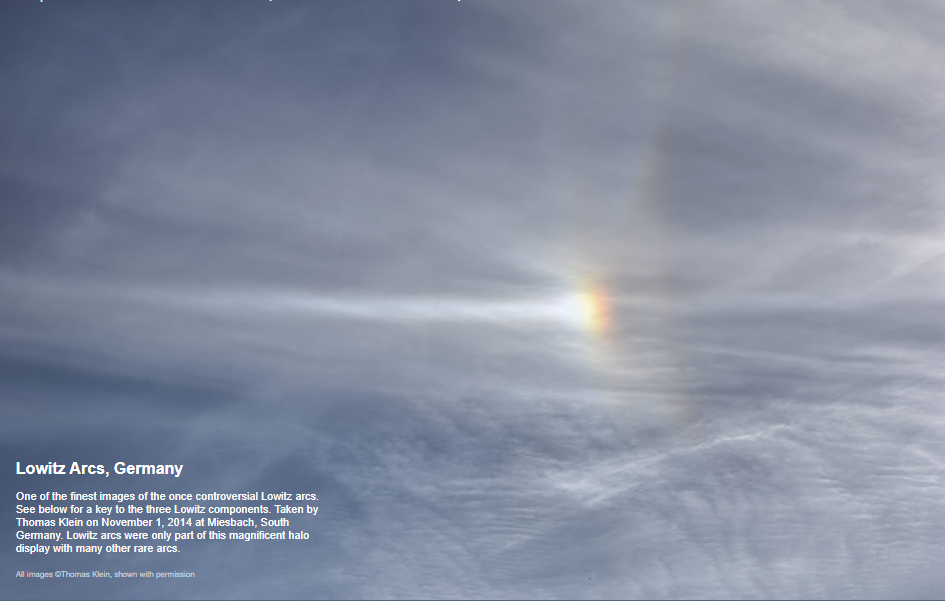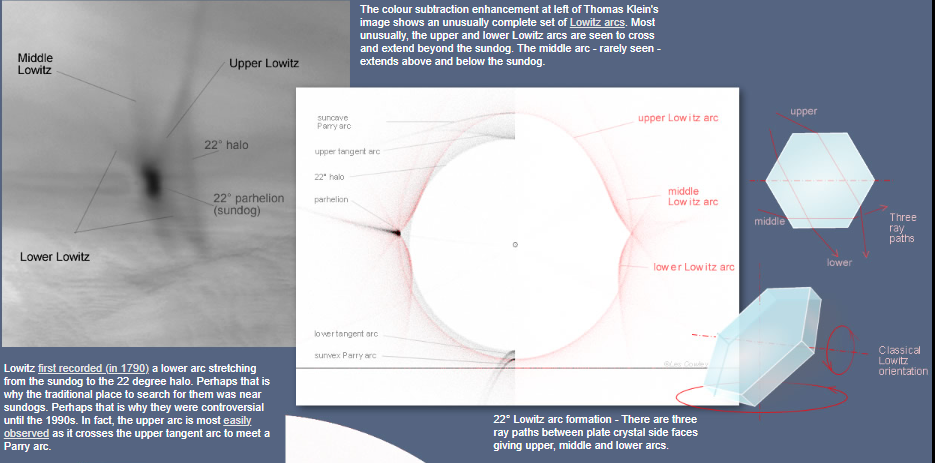Lowitz Arcs, Germany - OPOD
Lowitz Arcs, Germany - A Magnificent Halo Display
The Lowitz arcs, captured in a stunning image by Thomas Klein on November 1, 2014, in Miesbach, South Germany, are a remarkable atmospheric optical phenomenon. This particular image showcases the three components of the Lowitz arcs with exceptional clarity. The photograph also reveals other rare arcs that were part of this mesmerizing halo display.
The controversy surrounding Lowitz arcs can be traced back to their initial discovery by Christian Ludwig Lowitz in 1790. Lowitz first recorded a lower arc that extended from the sundog to the 22-degree halo. This observation led to the traditional practice of searching for Lowitz arcs near sundogs. However, it wasn't until the 1990s that these arcs gained wider acceptance and recognition.
The upper Lowitz arc, which is the most easily observed, crosses the upper tangent arc and meets a Parry arc. The middle arc, rarely seen, extends both above and below the sundog. The lower arc stretches from the sundog to the 22-degree halo. Together, these three arcs create a mesmerizing display of atmospheric optics.
The formation of the 22-degree Lowitz arc involves three ray paths between plate crystal side faces, resulting in upper, middle, and lower arcs. In a remarkable image captured by Thomas Klein, a color subtraction enhancement reveals not only the rare Parry supralateral (Tape) arcs but also the presence of 46-degree Lowitz arcs. It is worth noting that one of these arcs could be mistaken for a 46-degree circular halo fragment formed by randomly oriented crystals.
The HaloSim ray tracing further illustrates the Lowitz arcs, with all arcs displayed in red. The outer (46-degree) arcs are formed by rays traversing a crystal basal face and a hexagonal prism side face. Additionally, Thomas Klein's images showcase a unique arc known as a "helic" arc, which can also be generated by Lowitz crystals.
The Lowitz arcs captured in this image by Thomas Klein are truly exceptional and deserve recognition as one of the great halo displays. The intricate details and rare components of the Lowitz arcs make this particular phenomenon a sight to behold.
Please note that this article has been automatically converted from the old website and may not appear as originally intended. For the original article, you can visit the provided link.

Lowitz Arcs, Germany
One of the finest images of the once controversial Lowitz arcs. See below for a key to the three Lowitz components. Taken by Thomas Klein on November 1, 2014 at Miesbach, South Germany. Lowitz arcs were only part of this magnificent halo display with many other rare arcs.
All images ©Thomas Klein, shown with permission

The colour subtraction enhancement at left of Thomas Klein's image shows an unusually complete set of Lowitz arcs. Most unusually, the upper and lower Lowitz arcs are seen to cross and extend beyond the sundog. The middle arc - rarely seen - extends above and below the sundog.
Lowitz first recorded (in 1790) a lower arc stretching from the sundog to the 22 degree halo. Perhaps that is why the traditional place to search for them was near sundogs. Perhaps that is why they were controversial until the 1990s. In fact, the upper arc is most easily observed as it crosses the upper tangent arc to meet a Parry arc.

22° Lowitz arc formation - There are three ray paths between plate crystal side faces giving upper, middle and lower arcs.
A colour subtraction enhancement of the display made by Thomas Klein. It shows very rare (from Natural crystals) Parry supralateral (Tape) arcs. More tellingly, it shows 46° Lowitz arcs. One of them could be confused with a 46°circular halo fragment from randomly oriented crystals.
The HaloSim ray tracing at left shows all Lowitz arcs in red. The outer (46°) arcs are from rays traversing a crystal basal face and a hexagonal prism side face.
One of Thomas's images show a 'helic' arc - a form of this can also be generated by Lowitz crystals.
A display that deserves to go down as one of the great ones.
Note: this article has been automatically converted from the old site and may not appear as intended. You can find the original article here.
Reference Atmospheric Optics
If you use any of the definitions, information, or data presented on Atmospheric Optics, please copy the link or reference below to properly credit us as the reference source. Thank you!
-
<a href="https://atoptics.co.uk/blog/lowitz-arcs-germany-opod/">Lowitz Arcs, Germany - OPOD</a>
-
"Lowitz Arcs, Germany - OPOD". Atmospheric Optics. Accessed on November 24, 2024. https://atoptics.co.uk/blog/lowitz-arcs-germany-opod/.
-
"Lowitz Arcs, Germany - OPOD". Atmospheric Optics, https://atoptics.co.uk/blog/lowitz-arcs-germany-opod/. Accessed 24 November, 2024
-
Lowitz Arcs, Germany - OPOD. Atmospheric Optics. Retrieved from https://atoptics.co.uk/blog/lowitz-arcs-germany-opod/.